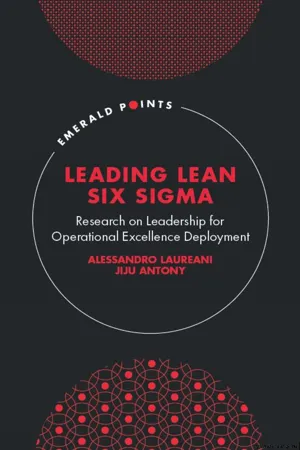
Leading Lean Six Sigma
Research on Leadership for Operational Excellence Deployment
- 148 pages
- English
- ePUB (mobile friendly)
- Available on iOS & Android
Leading Lean Six Sigma
Research on Leadership for Operational Excellence Deployment
About This Book
There is significant research available on critical success and failure factors of Lean Six Sigma implementation in organizations, predominantly focusing on the technical side of this performance method. But many organisations have overlooked soft skill aspects and the responsibilities of the Executive Leadership of the organization to make deployment a success.
Leading Lean Six Sigma: Research on Leadership for Operational Excellence Deployment assesses the impact of organizational leadership on the deployment of Lean Six Sigma in organisations. By identifying leadership as a critical success factor for Lean Six Sigma deployment in organizations, this book details what leadership traits are needed for a successful deployment, differentiating by industry sector, and presents a ground-breaking leadership dependency model. Alessandro Laureani and Jiju Antony's new research extends and refines the current understanding of Lean Six Sigma and leadership, identifying the traits a leader needs to display to increase the chances of successful deployment.
This book offers new perspectives for researchers examining Leadership, Management and Operational Excellence, as well as presenting useful guidance for practitioners launching, managing or sustaining continuous improvement initiatives in their organisations.
Frequently asked questions
Information
1
Introduction to Leadership for Lean Six Sigma
1.1 Introduction to Lean Six Sigma
- Lean is a process improvement methodology used to deliver products and services better, faster and at a lower cost. Womack and Jones (1996) defined it as ‘a way to specify value, line up value-creating actions in the best sequence, conduct those activities without interruption whenever someone requests them, and perform them more and more effectively. In short, lean thinking is lean because it provides a way to do more and more with less and less – less human effort, less human equipment, less time, and less space – while coming closer and closer to providing customers with exactly what they want’.
- Six Sigma is a data-driven process improvement methodology used to achieve stable and predictable process results, reducing process variation and defects. Snee (1999) defined it as ‘a business strategy that seeks to identify and eliminate causes of errors or defects or failures in business processes by focusing on outputs that are critical to customers’.
- Increased profits and financial savings
- Increased customer satisfaction
- Reduced cost
- Reduced cycle time
- Reduced inventory
- Improved quality
- Increased production capacity
- Linking to customer
- Vision and plan statement
- Communication
- Management involvement and participation
- Personal Lean Six Sigma experience of Top Management
- Development of the project leader's soft skills and supply chain focus
Table of contents
- Cover
- Title
- Copyright
- Contents
- List of Figures
- List of Tables
- About the Authors
- Preface
- Acknowledgements
- 1. Introduction to Leadership for Lean Six Sigma
- 2. Leadership Traits for Effective Deployment of Lean Six Sigma
- 3. The Role of the Organization’s Leader
- 4. Involving Everyone in the Lean Six Sigma Deployment
- 5. Launching, Managing and Sustaining Lean Six Sigma Deployment
- 6. Strategy Deployment and Lean Six Sigma
- 7. Integrating Innovation, Agile and Lean Six Sigma
- 8. Final Thoughts for Leaders
- References
- Index